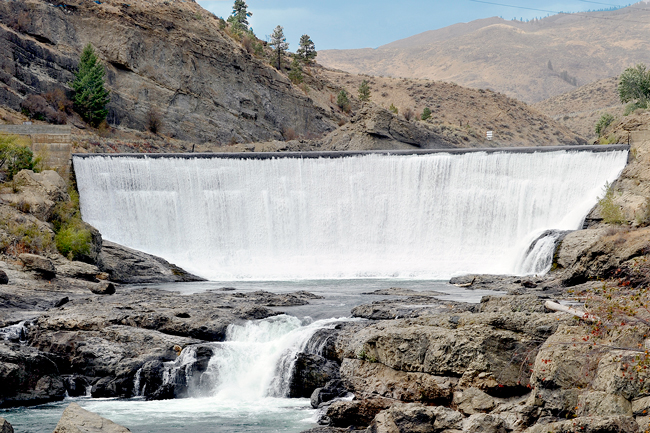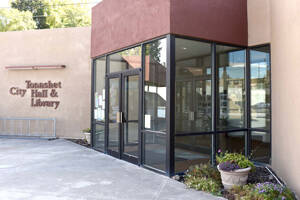
Group says ratepayers will get a negative return on investment
“The problem starts to become more evident around year 15. At that point, even though the annual losses are only up to the $2.5 million range, the year after year accumulation, plus interest, is starting to pile up.”
Anthony Jones, Founder
Rocky Mountain Econometrics
OROVILLE – An economic report on restoring hydropower at Enloe Dam outlines possible future costs of power produced by the dam ranging from $83 per megawatt hour (MWH), more than double the price of power on the open market, to $149/MWH, nearly four times the cost of power on the open market.

The report, submitted July 1, 2016 by Anthony Jones of Rocky Mountain Econometrics (www.rmecon.com) was prepared for Columbia River Bioregional Education Project (Columbiana) and is the third review of the economics of Okanogan PUD’s proposal to re electrify Enloe Dam on the Similkameen River, four miles upriver from Oroville.
The dam was decommissioned in 1958, and the PUD has tried to re-energize it four times. This most recent effort began in 2005, with the PUD submitting a Final License Application in 2008 and the Federal Energy Regulatory Commission (FERC) issuing the license July 8, 2013.
During the FERC application, around 2008 the PUD estimated construction costs of the project at $31 million, and estimated power produced at Enloe Dam would be $9.79/MWH cheaper than power available on the open market.
However, in a 2011 review of the application, RME noted the PUD did not recognize the sudden decrease in open market energy prices caused by the 2008/2009 recession. At this point, RME determined that power generated by Enloe would cost $31.16/MWH more than power available on the open market.
RME reviewed the project a second time in 2014, noting that inflation would have the cost of construction closer to $38 million, with open market energy prices declining further still, and no indication of an increase.
Soon after, the DOE was forced by the Washington Pollution Control Hearings Board (PCHB) to recognize the scenic and recreational values of the Similkameen Falls, and a six-day trial was held before PCHB in spring 2013 resulting in the PCHB ordering DOE to prepare an Aesthetic Flow study. This flow study would become the basis for the three year study of flow that could range from 10/30, to 100 to 300 cubic feet per second (cfs). Enloe Dam’s minimum to maximum Aesthetic Flow Studies will form the basis for evaluating Enloe Dam’s future prospects.
Using the Department of Ecology’s least restrictive flows of 10/30cfs (which the DOE will recalculate following three years of operation of the dam), costs of energy produced at Enloe were driven to about $47/MWH more than open-market energy by the increase of construction costs due to inflation.
In a November 17, 2014 Power Point presentation on Enloe Dam, the PUD detailed a revised estimate of construction costs for the powerhouse to be between $39 million and $45 million. That number is in addition to the $13 million of general revenue funds already spent on the project by the PUD between 2010 and 2015, which the PUD refers to as “sunk costs.” PUD’s 2016 budget calls for an additional $1.3 million of general funds to be spent on Enloe, bringing pre-construction costs to $14.4 million.
“When taking these costs into account, total spending on Enloe would be at least $53.4 million, and could easily reach $59.4 million or more,” writes Jones in his summary of the project.
“This ‘study’ was largely bogus when it was done in 2011,” said PUD Commissioner Ernie Bolz. “I think it has currently been resurrected by the “remove Enloe” folks because it is all they can come up with to keep their opinions in front of the public.”
According to Jones, issues outlined by RME in both their 2011 and 2014 reports remain in place today, including inflation driving up the cost for reconstruction of the dam; cost of power on the open market has not inflated; it remains undetermined how much water flow for aesthetics would be required by the DOE, which affects how much power Enloe would ultimately produce; and total costs for the project ballooning to as much as $59 million, or almost double the original cost estimate, which Okanogan County PUD ratepayers will be held responsible for paying.
In the 2016 RME analysis, Jones uses numbers submitted by the PUD to outline three possible cost scenarios of the project. The first and least restrictive scenario excludes the already spent “sunk costs,” assumes the cost of construction to remain at $39 million, and counts on flow requirements by the DOE remaining lenient at 10/30 cfs. This, the most favorable of the three scenarios, estimates power produced by Enloe to cost about $83/MWH. This is double the cost of power available on the open market.
The second scenario keeps the cost of construction at $39 million and assumes the DOE will keep the aesthetic flow requirement at 10/30 cfs, but includes $14.4 million of pre-construction “sunk cost” to be spent by the end of 2016. In this scenario, the cost of power generated at Enloe is expected to be about $110 million/MWH, close to three times the cost of open-market power.
The third scenario combines construction costs of $45 million with the $14.4 million pre-construction “sunk costs” for a total of $59.9 million. It includes the highest possible demand for aesthetic flow from the DOE at 300 cfs, leaving the cost to produce power at Enloe Dam at $149/MWH.
“If this alternative comes to pass, Okanogan County PUD ratepayers will be paying nearly four times as much for Enloe energy than power purchased on the open market,” said Jones.
“I am certain that the cost of electricity generated there will be competitive with ‘alternative energy’ power and will be more constant and reliable,” said Commissioner Bolz. “It will also be able to supply the residents of the Oroville area should the other sources of power coming into the county be compromised.”
“The PUD claims Enloe dam will produce an average of 4.5 MWH. That is about 1/3 of the demand of the Oroville substation,” said Oroville resident and Columbiana member Joseph Enzensperger.
Enzensperger said what concerned him the most about the re electrification of Enloe Dam was accrued debt from annual losses added on top of money borrowed to finance the project.
Jones details debt accumulated by the PUD from the Enloe project in Appendix 1 of RME’s 2016 analysis. According to Jones, in the first few years of the project the problem would not be too severe, with losses in year one projected to be $1.5 million, and total debt in the line of credit in year 5 up to $6.4 million.
“The problem starts to become more evident around year 15,” writes Jones. “At that point, even though the annual losses are only up to the $2.5 million range, the year after year accumulation, plus interest, is starting to pile up. In year 15 the line of credit is up to $31.4 million, within 20 percent of the construction cost of the dam. In year 30 the annual accumulation of debt, and interest on the debt, has driven debt in the line of credit account to $118 million, more than triple the cost of the project. At that point the cost of servicing the original debt, plus the cost of servicing the line of credit, drives annual losses up to $9.6 million, roughly six times the annual losses in year one.”
Jones then fast-forwards to year 42 of the project, with the original loan paid off at the end of year 40. Jones said while the annual debt service associated with that debt, $2.1 million per year, would cease, the debt in the line of credit account will have risen to $273 million.
“That’s more than seven times the original construction cost,” writes Jones. “At that point the project will be losing about $20 million per year and the amount will keep going up until the line of credit devours Okanogan County PUD.”
“It’s just a deep, deep black hole of debt they are falling into, and putting the ratepayers in,” said Enzensperger. “The PUD will be drawing us into a horrendous indebtedness.”
Commissioner Bolz doesn’t see it that way.
“Rates will not be impacted much, if at all, because the bonds we are currently paying off for our wind generation will be paid off by the time the Enloe project is completed,” said Bolz.
John Grubich, manager of the public utility said that FERC bases part of its licensing approval on economics.
“FERC granted our license based on our analysis and their opinion was the project was economically feasible,” said Grubich. “If it was important they would have conditioned the license based on that analysis.”
Energy Northwest (EN) is currently looking into taking on the project as the contractor to design, build and operate the dam. EN, created in 1957 by the Washington state legislature to serve public power utilities by generating reliable and low-cost energy, is a consortium of 27 public utility districts and municipalities. EN owns and operates the White Bluffs Solar Station, the Packwood Lake Hydroelectric Project, the Nine Canyon Wind Project and Columbia Generating Station, a nuclear energy facility.
The 2016 RME study can be viewed on the Columbiana website at www.columbiana.org.





